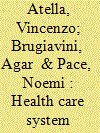| Srl | Item |
| 1 |
ID:
103913


|
|
|
|
|
| Publication |
2011.
|
| Summary/Abstract |
In a stimulating paper, Modigliani and Cao (2004) concluded that most of the huge increase in the household saving rate in China since 1975, the 'Chinese saving puzzle', can be explained by the life-cycle hypothesis. Their analysis is based on the estimation of reduced form equations. However, a structural model of their hypothesis would impose constraints on these equations. For not taking them into account, their test of the life-cycle hypothesis lacks power.
In this paper, we develop a structural model of household saving behavior based on the life-cycle hypothesis for the Chinese economy. We find that the life-cycle hypothesis can explain only 35% of the surge of the Chinese household saving. We then add to the model the strong motivation of young adults for buying a home and the financial support they receive from their parent for that. In this way, the model can reproduce the high and increasing level of saving since the mid-nineties. Nonetheless the increase in household saving, which took place during the eighties, may not be explained by the life-cycle hypothesis.
|
|
|
|
|
|
|
|
|
|
|
|
|
|
|
|
| 2 |
ID:
143418


|
|
|
|
|
| Summary/Abstract |
This paper aims to evaluate the impact of 1998 Chinese health care reform on out-of-pocket expenditure and on saving. Existing evidence on the results achieved by this reform in terms of reduction of out-of-pocket medical expenditures is still mixed and contradictory, and very little is known about the impact of these measures on the consumption and saving behavior of the Chinese population. To shed more light on this issue we use data collected in 1995 and 2002 by the Chinese Household Income Project (CHIP). Contrary to previous evidence, our findings suggest that the effects of the reform have been more articulated and heterogeneous. In fact, we find that once properly accounting for income distribution and unobserved heterogeneity (potentially induced by health status), out-of-pocket medical expenses and saving rate are affected by the reform in a differentiated way. In particular, we find that out-of-pocket expenses decrease only for high income individuals with good health status and the saving rate increases only for low income individuals with good health status. This result is actually worrisome, as it suggests that the public health coverage after the reform provides financial protection only to individuals that are relatively better off (with good health status and/or high income).
|
|
|
|
|
|
|
|
|
|
|
|
|
|
|
|